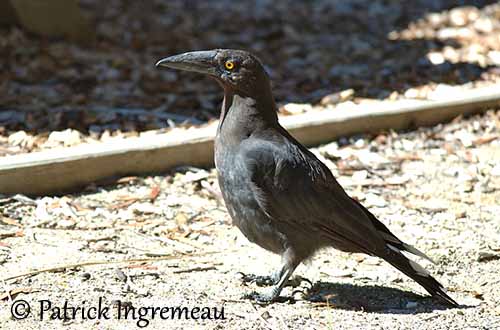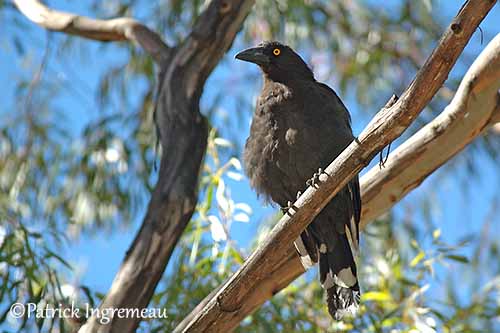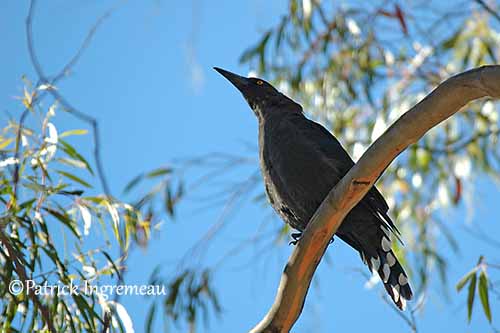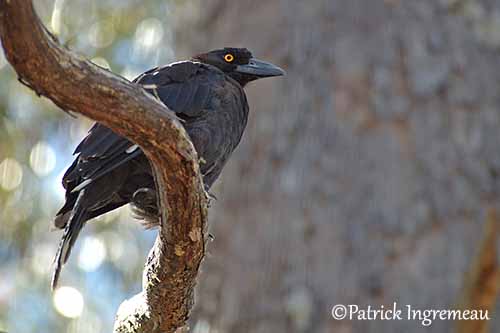
Fr: Réveilleur noir
All: Tasmanwürgerkrähe
Esp: Verdugo Fuliginoso
Ita: Cornacchia sibilante nera
Nd: Zwarte Klauwierkraai
Sd: Svart kurrawong
Photographer:
Patrick Ingremeau
TAMANDUA
Text by Nicole Bouglouan
Sources:
HANDBOOK OF THE BIRDS OF THE WORLD Vol 12 by Josep del Hoyo-Andrew Elliott-David Christie - Lynx Edicions - ISBN: 8496553423
L’ENCYCLOPEDIE MONDIALE DES OISEAUX - Dr Christopher M. Perrins - BORDAS - ISBN: 2040185607
BirdLife International (BirdLife International)
Birds in backyards (Birds Australia and Australian Museum)
Wikipedia, the free encyclopaedia
Black Currawong
Strepera fuliginosa
Passeriformes Order – Cracticidae Family
INTRODUCTION:
The Black Currawong is resident all year round in Tasmania and this species is endemic to this large island. It is omnivorous and well known as nest predator, especially in urban areas.
DESCRIPTION OF THIS SPECIES:
Biometrics:
Length: 49-50 cm
Weight: M: 365-457 g – F: 327-353 g
The adult resembles a Corvus crow. The nominate race is almost entirely black, but it becomes browner in worn plumage. We can see a white area at bases of primaries forming a white wingbar on the underwing, sometimes visible on the upperwing too. The flight feathers are white-tipped, with broader tips on the five outer primaries. The black tail shows rounded white tips.
The head is black and flattened.
The massive black bill has slightly hooked tip and curved upper mandible. The eyes are bright yellow. Legs and feet are black.
Both sexes are similar but the male is larger than the female.

The juvenile is mostly blackish-brown with streaked breast. The pale areas of wings and tail are creamy-white. The bill is paler, greyish-white, with yellow gape. The eyes are duller yellow. Legs and feet are dark grey.
The immature resembles adult in worn plumage, with creamy areas on wings and tail. The bill is black with pale yellow gape.
SUBSPECIES AND RANGE:
There are three subspecies.
S.f. fuliginosa (here described and displayed) is endemic to Tasmania.
S.f. colei is found on King I in W Bass Strait where it is resident. This race is the smallest with shorter tail.
S.f. parvior occurs on Furneaux Group in E Bass Strait where it is resident. This race is smaller than nominate with shorter tail too.

HABITAT:
The Black Currawong breeds throughout the highlands in subalpine forest such as cool temperate rainforest and wet Eucalyptus forests. It also occurs in heath lands and sedge lands.
Outside the breeding season, part of population moves in flocks of up to 50 individuals to lowland forests and woodlands, and to urban areas.
The subspecies living on islands in Bass Strait are found in drier forested habitats, coastal scrubs and beaches all year round.

CALLS AND SONGS: SOUNDS BY XENO-CANTO
The Black Currawong’s call is distinctive of Tasmanian highlands, and is described as loud, musical “kar-week, kar-week”. Some variants such as long rolling croak and incessant chattering scream are also heard “killok-killok”.
Both mates communicate by soft whistles and croaks, and they utter long, flute-like whistles when carrying food to the young.
BEHAVIOUR IN THE WILD:
The Black Currawong is omnivorous. It feeds primarily on insects and small vertebrates, also carrion, fruits, berries and seeds.
The two subspecies feed among piles of giant kelp on beaches, searching for fly larvae.
It usually feeds on the ground, but sometimes in tree canopy too. The large, strong bill is used for probing the ground or turning over clods of earth and leaf litter or small rocks. It may catch small birds in flight. It forages along the walking tracks and scavenge at picnic areas.
They often forage in pairs, but large groups of up to 100 birds may raid orchards for apples or rotten fruits.

The Black Currawong consumes berries from Ericaceae, domestic peas and apples. Invertebrates include earthworms and various insects such as ants, moths, flies, crickets, grasshoppers and beetles. It has learnt how to eat the introduced wasps.
Small vertebrates include small birds of various species, but also chickens, ducklings and young domestic turkeys, mice, small lizards, tadpoles and small rabbits.
This bird can be tame and opportunistic, especially in public parks where it gets food from humans.
During the breeding season, the Black Currawong breeds in pairs, and the breeding territory is strongly defended.
As male and female are living together all year round, the courtship displays are not elaborate.

Some observation of the Pied Currawong may suggest that the same displays are performed by the Black Currawong too.
These displays include some postures with drooped wings and cocked tail, and the bird holds this posture for 30-60 seconds near the nest. Food-begging display if performed by the female while giving begging calls like a juvenile.
Both sexes perform “solicitation-display” during which a bird crouches with quivering wings and looking at its or her mate. Sometimes, the neck is extended and the bill is pointed upwards. The tail can be wagged sideways too.
This display is usually performed prior to copulation.
The Black Currawong is resident in Tasmania, but it performs altitudinal movements in autumn and winter, descending from cold and snowy upland areas to lowland forests and urban areas.
Its flight is undulating with deep, jerky wingbeats, usually interspersed with deeper swoops with wings held close to the body.

REPRODUCTION OF THIS SPECIES:
The breeding season takes place between August and December.
Both sexes build a large cup-shaped nest with sticks and twigs. It is lined with softer materials such as grass, rootlets and strips of bark. It is placed in the fork of a tree, between 3 and 20 metres above the ground. An old nest of previous year can be tidied up and reused in following years.
The female lays 2-4 purplish-buff eggs with red-brown and purple markings. The incubation lasts about three weeks. At hatching, the chicks are naked and blind. They are fed by both parents, and remain in the nest during 28-31 days. When they leave the nest, the male alone feeds them. Both adults defend strongly the nest-site.
PROTECTION / THREATS / STATUS:
The Black Currawong has restricted range in which it is fairly common. The main threat is the clearing of native vegetation for agriculture expansion. This species is sometimes considered a pest in orchards and poultry farms.
The race “colei” of King I is listed as Vulnerable, but the nominate race is not currently threatened.
